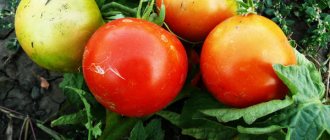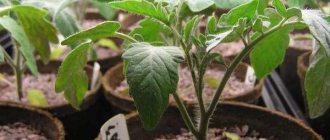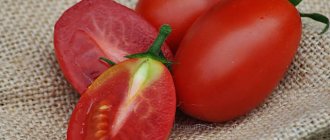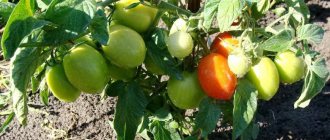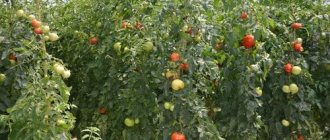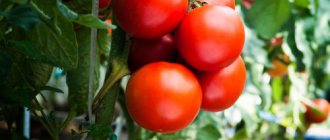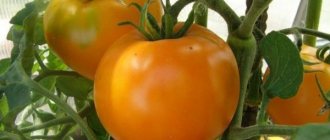The Japanese rose tomato will interest lovers of sweet pink fruits. This variety has excellent resistance to unfavorable conditions and consistently high yields. It is better to grow it in a greenhouse.
| Height | Landing location | Ripening time | Fruit color | Fruit size | Origin | Fruit shape |
| Medium height | Greenhouse, Open ground | Mid-season | Pink | Large | Variety | With spout |
Description of the variety
Japanese rose tomatoes were bred by Russian breeders. They were faced with the task of creating a crop ideal for growing in any climatic conditions with minimal labor costs. The result exceeded expectations: the determinate type plant shows excellent results when cultivated in greenhouses and open ground.
During the flowering period, the bushes look elegant and more like ornamental plants. Thanks to the abundant and beautiful flowering, the variety got its name.
The photo shows Japanese rose tomatoes.
Distinctive features
The variety has the following features:
- plant height - 60–80 cm;
- as the clusters grow, they form clusters with 5-6 fruits;
- branched bushes with strong rhizomes;
- does not need gartering or shaping.
Fruit characteristics, yield
Tomato variety Japanese rose:
- characterized by a high content of vitamins and microelements;
- suitable for allergy sufferers and baby food;
- have small dimensions, weight no more than 150 g;
- have a bright pink color and a round shape, reminiscent of a heart with a sharp tip;
- have a thin but at the same time durable skin and a ribbed stalk;
- not prone to cracking;
- have juicy sweet pulp with a small number of seeds;
- They are stored for a long time and tolerate transportation well.
The variety is characterized by high productivity. On average, 5-6 kg are collected from one bush, with a maximum of 8 kg.
What is a Japanese rose tomato?
Characteristics and description of the Japanese rose variety:
- The fruits of this variety are distinguished by a beautiful bright pink or raspberry-pink solid color, which immediately attracts the attention of gardeners and tomato lovers.
- Photos and reviews indicate that the brushes on which the fruits are formed independently gather into small clusters. There are only a few fruits on each cluster: 5 or 6. 1 Japanese rose fruit weighs almost 150 g or a little more.
- The fruits have a pointed tip, and there is ribbing near the stalk. But it is small, so it does not spoil the appearance of the tomato.
- A distinctive feature is that the tomato has a thin skin. At the same time, it is very strong, which does not allow the already ripe fruit to crack.
- The tomato has a sweet, sugary taste, the fruits ripen juicy, have a moderately dense center, and there are few seeds inside. From 1 bush you can harvest up to 6 kg of tomatoes.
- The plant is unpretentious, so you don’t need to take special care of the bushes. The height of each bush varies between 0.6-0.8 m. There are leaves on the bush, but there are few of them. There is no need to carry out stepsoning.
Japanese rose tomatoes contain a large amount of vitamins, microelements, and sugar, so the variety is used to make purees for small children. Allergists allow allergy sufferers to eat these tomatoes, since they will not cause the development of allergic reactions in various dishes such as soups, tomatoes and salads.
Thus, the characteristics of the Japanese rose variety show that this vegetable will become a real decoration for the dinner table. This plant is easy to grow in gardens, so summer residents willingly plant bushes on their plots.
Growing and caring for seedlings
The crop is grown by seedling method. Before sowing, the seeds are treated with growth stimulants. There is no need for disinfection, since the manufacturer took care of this. The process begins 50–60 days before the intended planting in the ground.
The seed material is soaked in biological preparations to accelerate germination (Zircon, Novosil, Epin-extra are suitable).
Soil for containers is prepared on the basis of black soil and sand and disinfected in the oven. Then mineral fertilizing is applied. After cooling, the soil is poured into plastic trays or special pots. The top layer is moistened with settled water at room temperature and the seeds are planted to a depth of 1–1.5 cm with an interval of 5 cm. A cellophane film is stretched over the top and left in a place inaccessible to sunlight at a temperature of +23 ° C until seedlings appear.
Then the film is removed and the seedlings are transferred to the windowsill. Picking is carried out after the first true leaves appear. To do this, take peat or plastic cups.
Important ! Young sprouts need good lighting. If it is not enough, additionally use phytolamps.
The seedlings are irrigated with warm water once every 2-3 days.
Care
It is recommended to retouch the seeds of this variety with a growth stimulant before sowing. No additional disinfection procedures are required. It is recommended to select soil in a ratio of mixed humus with turf and sand. Sowing occurs in a box in the ground to a depth of no more than 2 cm. To avoid germination of the maximum number of seedlings, it is advisable to maintain a constant temperature side by side of 25°.
After the first shoots appear, the boxes with seedlings are exposed either to the sun or under special lamps. The shoots must be watered with pre-settled warm water using a spray bottle.
It is recommended to transplant into a greenhouse to a permanent growing location in early May, and when growing in open beds - even closer to the beginning of June. The soil should be loosened, with holes pre-fertilized with a mineral composition. Keep every sq.m. no more than 3 plants are planted. You need to water intermittently, but a lot - warm water is needed for watering.
This breed does not require pinching or additional tying. Side shoots are removed only if the main stem of the plant is weakened.
During the entire growing season, it is recommended to feed the ass no more than 4 times.
Growing tomatoes
Film greenhouses are considered ideal conditions for cultivating the Japanese rose variety. In the southern regions of the country, planting in open ground is acceptable.
Landing
Planting of plants in greenhouses begins in early May . By this time, the tomatoes will have become stronger and will be ready for “relocation”. To plant outdoors, wait until early June to ensure there is no threat of frost.
The soil is first loosened and fertilizers are applied. The holes are dug at a depth of 15 cm and moistened abundantly with warm water. For the purpose of disinfection, the soil is watered with a strong solution of potassium permanganate.
Planting density is no more than 3 seedlings per 1 m2.
Care
Compliance with the rules of caring for seedlings ensures stable yields:
- The bushes are formed into 1-2 stems so that nutrients can easily penetrate into the fruits.
- Before the first cluster appears, the plants are periodically pruned.
- Greenhouses ensure optimal air circulation and sufficient lighting.
- The culture needs abundant but infrequent watering with warm, settled water. Pour it at the root, trying not to get on the foliage.
Throughout the growing season, 3-4 feedings are carried out. First, nitrogen is added, then potassium and phosphorus (Superphosphate and Urea are suitable). Organomineral fertilizers are just gaining popularity and may soon take a leading position. Such fertilizers consist of substances of mineral and organic origin. Together, they improve the composition of the soil, eliminate the lack of nutrients, and increase the fruiting period. “Signor Tomato” and “Baby” are considered the best.
Productivity
- Feed tomatoes no more than 2-3 times a month.
Both complex fertilizers and nitrogen and potassium fertilizers are perfect for this. When purchasing, pay attention to the composition: it is worth purchasing fertilizers with the maximum content of phosphorus and potassium. Feeding is necessary at the stage of bush formation (discussed above), as well as at the stage of budding and formation of the vegetable. Do not forget to feed the seedlings a week after transplanting into the ground.
We invite you to read: Growth stimulants for indoor plants
An important and necessary procedure, especially after applying fertilizer. It helps not only to saturate the roots with air, but also ensures the best penetration of beneficial microelements and minerals into the bush. Loosening is also required after watering.
They can not only completely hide tomatoes from the sun, but also cause more serious and irreparable damage. Always keep your garden beds clean.
It seemed that it could be even simpler, but it is errors in watering that lead to the development of fungal diseases and death of the root system. Water strictly at the root, water should not get on the leaves. Ideal time: early morning before sunrise and late evening after sunset.
It is extremely necessary to ventilate the greenhouse and monitor the temperature inside, because high humidity not only leads to the appearance of fungus, but can also completely destroy the bushes.
Diseases and pests
The Japanese rose variety is resistant to late blight and fusarium. Nevertheless, preventive treatment against bacterial damage and insect pests will not hurt tomatoes.
Before planting seedlings, the soil is treated with copper sulfate or a strong solution of potassium permanganate, which kill microbes. Treatment with Fitosporin prevents fungal infection.
If signs of phytosporosis disease are detected (brown spots and stripes on petioles and stems, gray-brown on fruits and leaves), the affected greens and tomatoes are removed, and the bushes are irrigated with copper sulfate.
Spraying helps fight spider mites, thrips, and whiteflies:
- celandine decoction (400 g of fresh herbs, pour 1 liter of boiling water, leave for 24 hours);
- infusion of onion peel (100 g of raw material, pour 5 liters of cold water, leave for 5-6 days);
- insecticides "Tanrek", "Break", "Novaction", "Sirocco".
Ammonia is effective against slugs: dilute 500 ml of 10% solution in 2.5 liters of water and irrigate the bushes.
A solution of laundry soap helps destroy aphids. Grate 2 pieces of laundry or tar soap and pour in 2 liters of warm water, stir until completely dissolved and add another 8 liters of water. Spray the bushes with the mixture.
Advantages and disadvantages
The advantages of the Japanese rose include:
- ease of care;
- juicy and sugary pulp with a minimal amount of acid;
- high productivity;
- resistance to viral infections;
- no need for a garter;
- possibility of storage in a cool place for 1-2 months without loss of quality;
- small number of seeds;
- high resistance to transportation.
As growing experience shows, the Japanese rose has no obvious disadvantages. To succeed, you just need to follow the rules of watering, apply fertilizers on time and treat the bushes from insects.
Farmer reviews
Despite the fact that the variety appeared on the market relatively recently, many have managed to appreciate it.
Nadezhda, Shuya: “I tried to grow the variety in open ground, although it is intended for greenhouses. The yield was lower than stated, but there were no problems with seedling germination and further care. The tomatoes have a pleasant sweet taste, the skin does not crack, and they last a long time in a cold place.”
Oksana, Bobrov: “I planted the Japanese rose variety last year as an experiment: several bushes in a greenhouse and in the open air. The culture is unpretentious in care and rarely gets sick. I used to think that tall bushes were more suitable for a greenhouse, but I radically changed my mind. The harvest was a great success, the tomatoes were identical, bright pink and very tasty. In open ground, tomatoes grew without problems, but the yield was no more than 2-3 kg per bush.”


